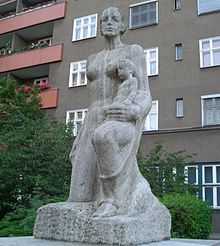Josef Thorak

Josef Thorak (7 February 1889 in Salzburg, Austria – 26 February 1952 in Hartmannsberg, Bavaria) was an Austrian-German sculptor. He was well known for his "grandiose monuments".[1]
Life and career
Thorak's reputation was established in 1922 when he created Der sterbende Krieger (The Dying Warrior), a statue memorializing the dead of World War I in Stolpmünde.
In 1933, Thorak joined Arno Breker as one of the two "official sculptors" of the Third Reich.[2] In his government-approved studio outside Munich, Thorak worked on statues intended to represent the folk-life of Germany under Nazi leadership; these works tended to be heroic in scale, up to 65 feet (20 meters) in height. His official works from this period included a number of sculptures at the Berlin Olympic Stadium of 1936.
Albert Speer referred to Thorak as "more or less my sculptor, who frequently designed statues and reliefs for my buildings" and "who created the group of figures for the German pavilion at the Paris World's Fair.[3] His statue Comradeship stood outside the pavilion, depicting two enormous nude males, clasping hands and standing defiantly side by side, in a pose of racial camaraderie.[4]
Because of his preference for muscular neo-classical nude sculpture, Thorak was known among some as "Professor Thorax". Some expressionist influences can be noticed in his generally neoclassical style.
See also
References
- ↑ Rhodes, Anthony, ‘’Propaganda: The Art of Persuasion: World War II’’ Chelsea House Publishers, New York, 1976 , p. 28
- ↑ "Art: Bigger Than Life"
- ↑ Speer, Albert, Spandau: the Secret Diaries’’, Macmillan Publishing Co., Inc. New York, 1976, p. 261
- ↑ Richard Overy, The Dictators: Hitler's Germany, Stalin's Russia, p260 ISBN 0-393-02030-4
External links
![]() Media related to Josef Thorak at Wikimedia Commons
Media related to Josef Thorak at Wikimedia Commons
|